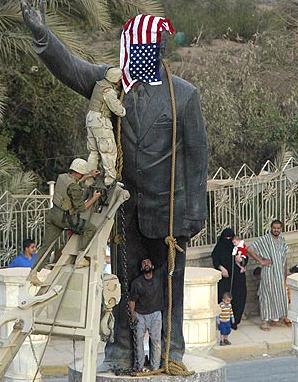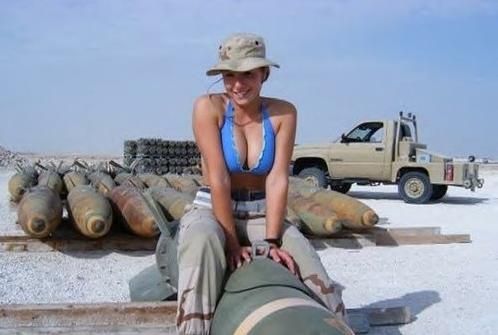 Remember from earlier this week?
Remember from earlier this week?“I said, ‘Jesus Christ, John, this is a recipe for disaster,’ ” General Keane told Army historians. “I was upset about it to say the least, but the decision had been made and it was a done deal.”
...
The story of the American occupation of Iraq has been the subject of numerous books, studies and memoirs. But now the Army has waded into the highly charged debate with its own nearly 700-page account: “On Point II: Transition to the New Campaign.”
Looking over the OIF Lessons Learned, I think there are a few areas I am interested in your thoughts on, as recommended by one of my spies.- Ch. 2: Pages 65-80
- Ch. 3: Pages 87-92
- Ch. 4: Pages 161-170 (esp. 169-70)
- Ch. 9: Pages 367-400
- Ch. 14: Pages 567-584
My observations can be boiled down to just a few items:- The problems with the post invasion challenges in Iraq were at least 51% the fault of the military, not our civilian masters or policy-mongers. We did not source our GOFO with the Staff they needed to plan properly. We did not push harder when it was needed. Especially when it comes to WMD, the fault is ours. I was there - I saw the briefs - I saw the intel. We fell in love with "Shock & Awe," we sold the sexy over the known. Generals like Shinseki were more focused on making points (and pushing bad ideas and unneeded pets like the Crusader) than providing doable options. We were focused so much on what was next as opposed to getting the now right.
- Good people can make honest mistakes - in this line of work that puts blood, treasure, and national honor on the line. When an armed forces fails at sea or ashore, more often than not the military should inspect itself before pointing fingers in other directions.
- To the great credit of the authors of this report, they do not point fingers. They find the fault, mostly and in a very tender well-worded way, where it belongs - with the U.S. Military.
The conclusion is spot on....
A more important reason for undertaking this project is to attempt to meet the charge posed by historians since the time of Herodotus and Thucydides some 3,000 years ago—to discern insights from the past that will cast a light, however bright or dim, that might guide today’s leaders into an uncertain future. The challenges in discerning those insights, with so little historical perspective about what are on-going events, are immense. Yet some insights have emerged from this study and the Army must capitalize on them.
...
 The subtitle of On Point II—Transition to a New Campaign—was not idly chosen. Not only does the phrase “transition to a new campaign” accurately capture the Army’s experience in Iraq between May 2003 and January 2005, it embodies what the authors believe is the most significant insight provided by the historical record. That observation looks beyond the rather obvious lesson that military forces must be prepared for the operations that follow success in tactical-level combat missions. The superb Soldiers of the US Army improvised and adapted to unexpected circumstances in Iraq as they have in similar situations for more than 200 years. Far more critical is the planning and preparation that civilian leaders and military commanders must conduct for the transition to operations that follow the decisive combat phase of a campaign.
The subtitle of On Point II—Transition to a New Campaign—was not idly chosen. Not only does the phrase “transition to a new campaign” accurately capture the Army’s experience in Iraq between May 2003 and January 2005, it embodies what the authors believe is the most significant insight provided by the historical record. That observation looks beyond the rather obvious lesson that military forces must be prepared for the operations that follow success in tactical-level combat missions. The superb Soldiers of the US Army improvised and adapted to unexpected circumstances in Iraq as they have in similar situations for more than 200 years. Far more critical is the planning and preparation that civilian leaders and military commanders must conduct for the transition to operations that follow the decisive combat phase of a campaign.
If the Army’s experience in Iraq in 2003 offers any single crucial insight, it is that this type of thoughtful, detailed, and deliberate planning must be done at the highest levels long before the campaign begins if military victory is to be transformed into strategic success.
The difficulty in Iraq in April and May 2003 for the Army, and the other Services, was that the transition to a new campaign was not well thought out, planned for, and prepared for before it began. Additionally, the assumptions about the nature of post-Saddam Iraq on which the transition was planned proved to be largely incorrect. Thus, as the US Armed Forces transitioned in April and May 2003 from Phase III, Decisive Operations, to what was essentially a new campaign that featured full spectrum operations, they did not have the benefit of policies and plans that fully envisioned the transition to guide their operations.
CENTCOM’s planned transition to Phase IV operations included only the final destruction of Saddam’s military and paramilitary forces, the search for weapons of mass destruction (WMD), the hunt for terrorists, and limited support to the humanitarian and reconstruction efforts of the Office of Reconstruction and Humanitarian Assistance (ORHA), all in the context of a rapid turnover of sovereignty to a new Iraqi Government.
 As late as May 2003 the CENTCOM commander planned for the rapid withdrawal of US and Coalition military forces by September as responsibility for Iraq was turned over to the ORHA, to the new joint task force, to international organizations, and to a new Iraqi Government. In line with that thinking was the CENTCOM decision to unexpectedly turn over responsibility for Phase IV of OIF to the V Corps headquarters, designated as Combined Joint Task Force–7 (CJTF-7), and to withdraw its land forces component command, Third Army, from the theater. General Tommy Franks also decided to retire during this time, believing his military service to the nation had been accomplished, much as he believed CENTCOM’s mission to depose Saddam Hussein was at a close.
As late as May 2003 the CENTCOM commander planned for the rapid withdrawal of US and Coalition military forces by September as responsibility for Iraq was turned over to the ORHA, to the new joint task force, to international organizations, and to a new Iraqi Government. In line with that thinking was the CENTCOM decision to unexpectedly turn over responsibility for Phase IV of OIF to the V Corps headquarters, designated as Combined Joint Task Force–7 (CJTF-7), and to withdraw its land forces component command, Third Army, from the theater. General Tommy Franks also decided to retire during this time, believing his military service to the nation had been accomplished, much as he believed CENTCOM’s mission to depose Saddam Hussein was at a close.
CENTCOM and Third Army did only the barest planning for Phase IV of OIF. The CFLCC plan for this phase was not formally issued until the start of the ground invasion of Iraq. Few if any commanders at all levels had any idea what their missions in Phase IV were to encompass. Lieutenant General (Retired) Jay Garner and the ORHA, created 20 January 2003, barely had time to build a staff and do a limited analysis of its tasks before it deployed to Kuwait in late March. US civilian and military planning and preparation, even for what was assumed to be a relatively easy and short Phase IV, was inadequate. Though essentially a joint planning process, the Army, as the Service primarily responsible for ground operations, should have insisted on better Phase IV planning and preparations through its voice on the Joint Chiefs of Staff.
 It is an open question whether senior US civilian and military leaders should have known their optimistic assumptions about the nature of post-Saddam Iraq would prove to be flawed. Many have pointed to official and unofficial prewar studies and predictions of chaos and conflict in Iraq after Saddam was overthrown. Others have pointed to voices in the US Armed Forces and Department of Defense (DOD) who questioned the relatively small number of troops planned for the postconflict phase of OIF. Historians have even questioned the assumption that the Iraqi nation-state was viable, noting its history under Ottoman, British, and Baathist rule as obscuring the underlying sources of friction and disunity—a sort of Middle Eastern version of the former Yugoslavia. It appears that most senior civilian and military leaders failed to review the historical records of military occupations and of Middle Eastern or Iraqi history, and also failed to listen and evaluate outside views about potential weaknesses with their planning assumptions.
It is an open question whether senior US civilian and military leaders should have known their optimistic assumptions about the nature of post-Saddam Iraq would prove to be flawed. Many have pointed to official and unofficial prewar studies and predictions of chaos and conflict in Iraq after Saddam was overthrown. Others have pointed to voices in the US Armed Forces and Department of Defense (DOD) who questioned the relatively small number of troops planned for the postconflict phase of OIF. Historians have even questioned the assumption that the Iraqi nation-state was viable, noting its history under Ottoman, British, and Baathist rule as obscuring the underlying sources of friction and disunity—a sort of Middle Eastern version of the former Yugoslavia. It appears that most senior civilian and military leaders failed to review the historical records of military occupations and of Middle Eastern or Iraqi history, and also failed to listen and evaluate outside views about potential weaknesses with their planning assumptions.
The intense desire to continue DOD’s transformation to smaller and lighter forces, to implement a perceived revolution in military affairs in the information age, and to savor the euphoria over seemingly easy successes in Afghanistan using those techniques seemed to outweigh searching through the past for insights into the future.

What lesson that last picture holds for me from OIF - I will keep to myself.
 Remember from earlier this week?
Remember from earlier this week?The subtitle of On Point II—Transition to a New Campaign—was not idly chosen. Not only does the phrase “transition to a new campaign” accurately capture the Army’s experience in Iraq between May 2003 and January 2005, it embodies what the authors believe is the most significant insight provided by the historical record. That observation looks beyond the rather obvious lesson that military forces must be prepared for the operations that follow success in tactical-level combat missions. The superb Soldiers of the US Army improvised and adapted to unexpected circumstances in Iraq as they have in similar situations for more than 200 years. Far more critical is the planning and preparation that civilian leaders and military commanders must conduct for the transition to operations that follow the decisive combat phase of a campaign.
As late as May 2003 the CENTCOM commander planned for the rapid withdrawal of US and Coalition military forces by September as responsibility for Iraq was turned over to the ORHA, to the new joint task force, to international organizations, and to a new Iraqi Government. In line with that thinking was the CENTCOM decision to unexpectedly turn over responsibility for Phase IV of OIF to the V Corps headquarters, designated as Combined Joint Task Force–7 (CJTF-7), and to withdraw its land forces component command, Third Army, from the theater. General Tommy Franks also decided to retire during this time, believing his military service to the nation had been accomplished, much as he believed CENTCOM’s mission to depose Saddam Hussein was at a close.
It is an open question whether senior US civilian and military leaders should have known their optimistic assumptions about the nature of post-Saddam Iraq would prove to be flawed. Many have pointed to official and unofficial prewar studies and predictions of chaos and conflict in Iraq after Saddam was overthrown. Others have pointed to voices in the US Armed Forces and Department of Defense (DOD) who questioned the relatively small number of troops planned for the postconflict phase of OIF. Historians have even questioned the assumption that the Iraqi nation-state was viable, noting its history under Ottoman, British, and Baathist rule as obscuring the underlying sources of friction and disunity—a sort of Middle Eastern version of the former Yugoslavia. It appears that most senior civilian and military leaders failed to review the historical records of military occupations and of Middle Eastern or Iraqi history, and also failed to listen and evaluate outside views about potential weaknesses with their planning assumptions.

No comments:
Post a Comment